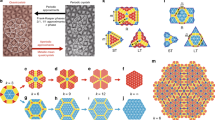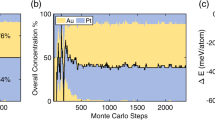Abstract
Recently the announcement was made of the remarkable discovery of intermetallic compounds with approximate composition MAl6 (M = Cr, Mn, Fe) that formed crystals or pseudocrystals with icosahedral symmetry, as shown by the shape of the small nodules and by their electron diffraction patterns1. I have found it hard to believe that any single crystal with 5-fold axes could give reasonably sharp diffraction patterns, resembling those given by crystals, and I have not been convinced to the contrary by the theoretical discussions of this possibility that have been published2–7. I therefore set myself the task of predicting how a molten alloy of Mn (or Cr or Fe) and Al might react to sudden cooling. I have discovered that such an alloy on sudden cooling could form a metastable cubic crystal with a large cube edge, about 26.7 Å, with the unit cube containing about 1,120 atoms (possibly a few more), and that these crystals would show ordered multiple growth such that 20 of them, roughly tetrahedral in shape, grow out from a central seed in such a way as to produce an aggregate with approximately icosahedral symmetry.
This is a preview of subscription content, access via your institution
Access options
Subscribe to this journal
Receive 51 print issues and online access
$199.00 per year
only $3.90 per issue
Buy this article
- Purchase on Springer Link
- Instant access to full article PDF
Prices may be subject to local taxes which are calculated during checkout
Similar content being viewed by others
References
Shechtman, D., Blech, I., Gratias, D. & Cahn, J. W. Phys. Rev. Lett. 53, 1951 (1984).
Shechtman, D. & Blech, I. Metal Trans. (in the press).
Levine, D. & Steinhardt, P. J. Phys. Rev. Lett. 53, 2477 (1984).
Bak, P. Phys. Rev. Lett. 54, 1517 (1985).
Levine, D. et al. Phys. Rev. Lett. 54, 1520 (1985).
Mermin, N. D. & Trorian, S. M. Phys. Rev. Lett. 54, 1524 (1985).
Heiney, P. A. Nature 315, 178 (1985).
Pauling, L. The Nature of the Chemical Bond 3rd edn (Cornell University Press, Ithaca, 1960).
Adam, J. & Rich, J. B. Acta crystallogr. 7, 813 (1954).
Pauling, L. & Marsh, R. E. Proc. natn. Acad. Sci. U.S.A. 36, 112 (1952).
Claussen, W. F. J. Chem. Phys. 19, 259,662, 1425 (1951).
Samson, S. in Structural Chemistry and Molecular Biology (eds Rich, A. & Davidson, N.) 687–717 (Freeman, San Francisco, 1968).
Samson, S. Nature 195, 259–262 (1962).
Samson, S. Acta crystallogr. 17, 491 (1964).
Samson, S. Acta crystallogr. 19, 401 (1965).
Pauling, L. J. Am. chem. Soc. 45, 2777 (1923).
Bergman, G., Waugh, J. L. T. & Pauling, L. Nature 169, 1057–1058 (1952); Acta crystallogr. 10, 254 (1957).
Author information
Authors and Affiliations
Rights and permissions
About this article
Cite this article
Pauling, L. Apparent icosahedral symmetry is due to directed multiple twinning of cubic crystals. Nature 317, 512–514 (1985). https://doi.org/10.1038/317512a0
Received:
Accepted:
Published:
Issue Date:
DOI: https://doi.org/10.1038/317512a0
This article is cited by
-
Quasicrystals: A New Class of Structurally Complex Intermetallics
Journal of the Indian Institute of Science (2022)
-
The Equivalence Between Unit-Cell Twinning and Tiling in Icosahedral Quasicrystals
Scientific Reports (2017)
-
Symmetry of icosahedral quasicrystals
Structural Chemistry (2015)
-
What is a crystal?
Nature (2014)
-
The hidden structure of liquids
Nature Materials (2014)
Comments
By submitting a comment you agree to abide by our Terms and Community Guidelines. If you find something abusive or that does not comply with our terms or guidelines please flag it as inappropriate.



